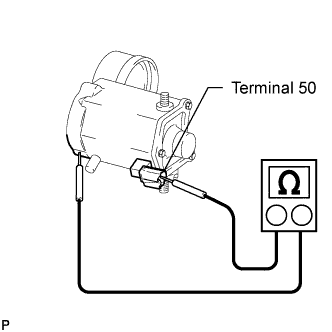Starter (For Denso Made) -- Inspection |
| 1. INSPECT STARTER ASSEMBLY |

- CAUTION:
- These tests must be performed within 3 to 5 seconds to prevent the coil from burning out.
Perform pull-in test.
Remove the nut, then disconnect the field coil lead wire from terminal C.
Connect the battery to the magnet starter switch as shown in the illustration. Then check that the clutch pinion gear moves outward.
If the clutch pinion gear does not move, replace the magnet starter switch assembly.
Perform holding test.
When the battery is connected as above with the clutch pinion gear out, disconnect the negative (-) lead from terminal C. Check that the pinion gear remains out.
If the clutch pinion gear moves inward, replace the magnet starter switch assembly.
Inspect clutch pinion gear return.
Disconnect the negative (-) lead from the starter body. Check that the clutch pinion gear returns inward.
If the clutch pinion gear does not return inward, replace the magnet starter switch assembly.
Perform the operation test without load.
Connect the field coil lead wire to terminal C with the nut.
- Torque:
- 5.9 N*m{60 kgf*cm, 52 in.*lbf}
Mount the starter in a vise between aluminum plates.
Connect the battery and an ammeter to the starter as shown in the illustration.

Check that the starter rotates smoothly and steadily while the pinion gear is moving outward. Then measure the current.
- Standard current:
- 120 A or less at 11.5 V
| 2. INSPECT STARTER ARMATURE ASSEMBLY |
Measure the resistance.
Measure the resistance between the segments of the commutator.
- Standard resistance:
- Below 1 Ω
Measure the resistance between a segment of the commutator and the armature coil core.
- Standard resistance:
- 10 kΩ or higher


Inspect circle runout.
Place the armature on V-blocks.
Using a dial gauge, measure the circle runout.
- Maximum circle runout:
- 0.05 mm (0.0020 in.)
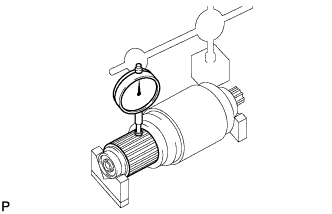 |
Using a vernier caliper, measure the commutator diameter.
- Standard commutator diameter:
- 35.0 mm (1.378 in.)
- Minimum commutator diameter:
- 34.0 mm (1.339 in.)
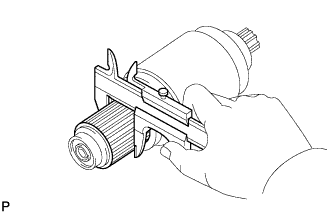 |
Measure the undercut depth of the commutator.
- Standard undercut depth:
- 0.7 mm (0.028 in.)
- Minimum undercut depth:
- 0.2 mm (0.008 in.)
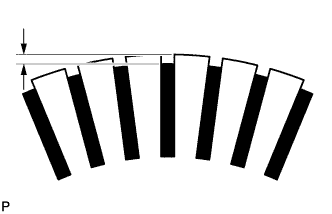 |
Inspect the armature bearings.
Check that the armature bearings rotate smoothly.
If the result is not as specified, replace the armature assembly.
| 3. INSPECT STARTER YOKE ASSEMBLY |
Inspect the field coil for an open circuit.
Measure the resistance between the lead wire and field coil brush lead.
- Standard resistance:
- Below 1 Ω
 |
Inspect the ground.
Measure the resistance between the lead wire and starter yoke body, and between the brushes and starter yoke body.
- Standard resistance:
- 10 kΩ or higher
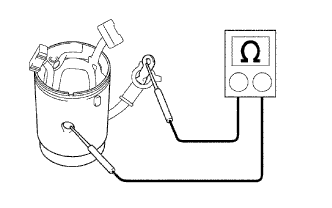 |
| 4. INSPECT BRUSH |
Using a vernier caliper, measure the brush length.
- Standard length:
- 16.5 mm (0.650 in.)
- Minimum length:
- 9.0 mm (0.354 in.)
 |
| 5. INSPECT STARTER BRUSH HOLDER ASSEMBLY |
Inspect the brush insulation.
Using an ohmmeter, measure the resistance between the positive and negative brush holders.
- Standard resistance:
- 10 kΩ or higher
 |
Take a pull scale reading the instant the brush spring separates from the brush.
- Standard spring load:
- 26.5 to 32.3 N (2.7 to 3.3 kgf, 5.9 to 7.3 lbf)
- Minimum spring load:
- 17.6 N (1.8 kgf, 4.0 lbf)
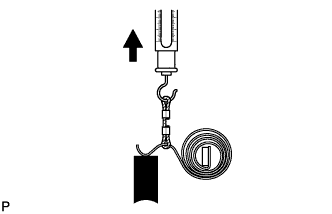 |
| 6. INSPECT STARTER CLUTCH SUB-ASSEMBLY |
Rotate the pinion gear clockwise and check that it turns freely. Try to rotate the pinion gear counterclockwise and check that it locks.
If the result is not as specified, replace the clutch sub-assembly.
 |
| 7. INSPECT MAGNET STARTER SWITCH ASSEMBLY |
Check if the pull-in coil has an open circuit.
Measure the resistance between terminal 50 and terminal C.
- Standard resistance:
- Below 1 Ω

Check if the hold-in coil has an open circuit.
Measure the resistance between terminal 50 and the switch body.
- Standard resistance:
- Below 2 Ω
